Marketing Fundamentals: Branding, Product Development and Market Research
VerifiedAdded on 2022/11/17
|11
|1783
|315
AI Summary
This document covers the basics of marketing fundamentals including branding, product development and market research. It explains the importance of branding, strategies for brand management, new product development stages, types of marketing research and more.
Contribute Materials
Your contribution can guide someone’s learning journey. Share your
documents today.
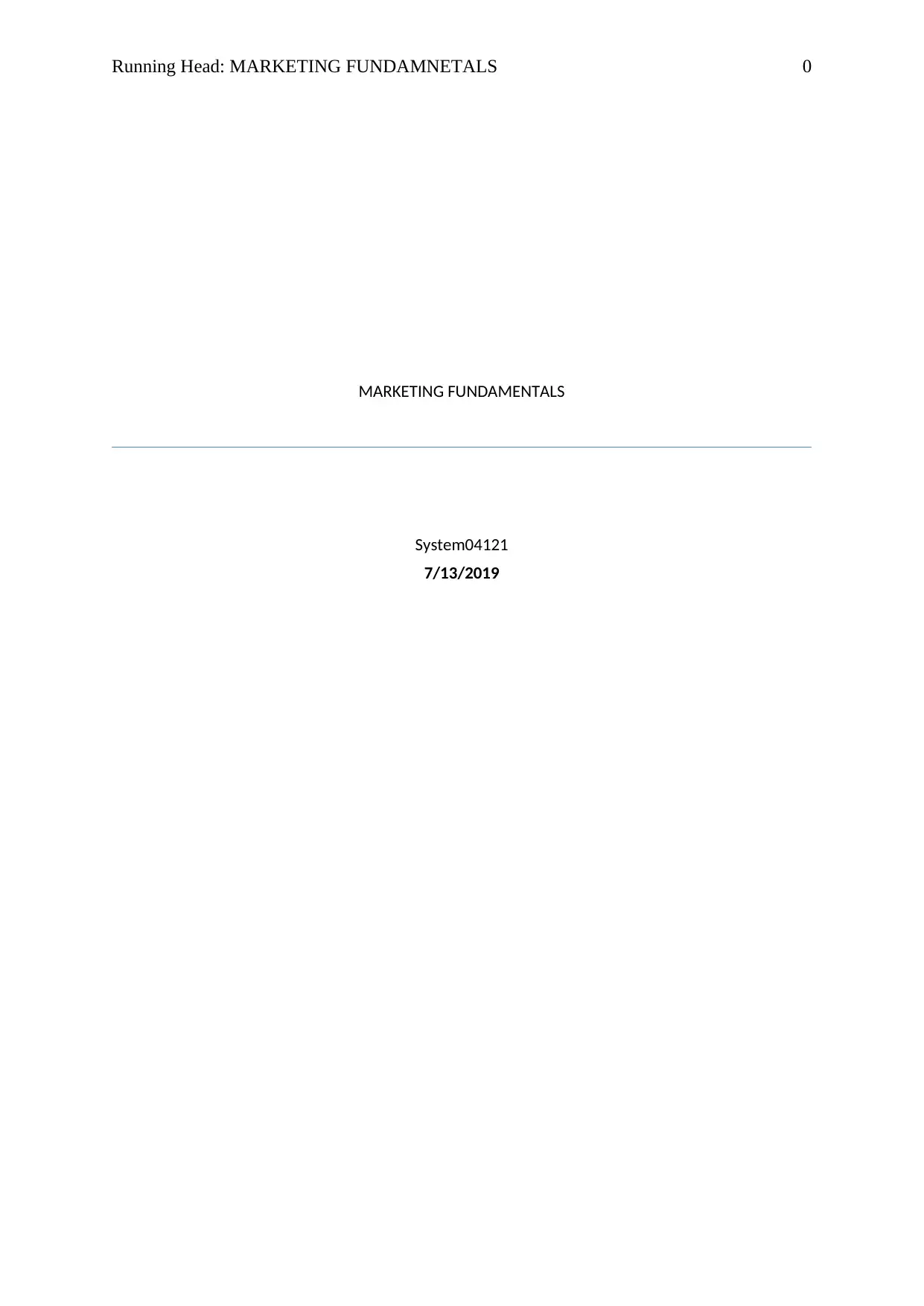
Running Head: MARKETING FUNDAMNETALS 0
MARKETING FUNDAMENTALS
System04121
7/13/2019
MARKETING FUNDAMENTALS
System04121
7/13/2019
Secure Best Marks with AI Grader
Need help grading? Try our AI Grader for instant feedback on your assignments.
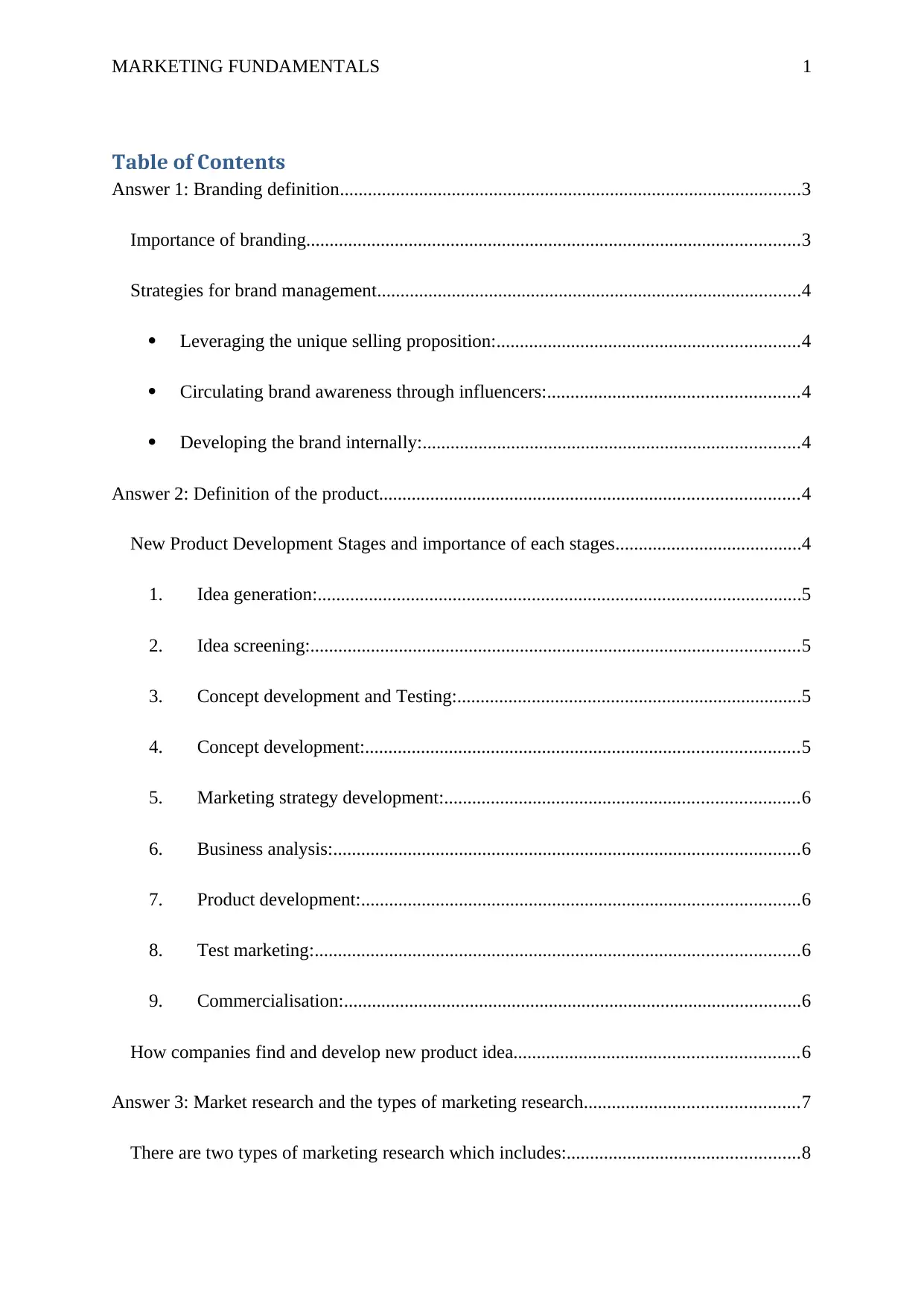
MARKETING FUNDAMENTALS 1
Table of Contents
Answer 1: Branding definition...................................................................................................3
Importance of branding..........................................................................................................3
Strategies for brand management...........................................................................................4
Leveraging the unique selling proposition:.................................................................4
Circulating brand awareness through influencers:......................................................4
Developing the brand internally:.................................................................................4
Answer 2: Definition of the product..........................................................................................4
New Product Development Stages and importance of each stages........................................4
1. Idea generation:........................................................................................................5
2. Idea screening:.........................................................................................................5
3. Concept development and Testing:..........................................................................5
4. Concept development:.............................................................................................5
5. Marketing strategy development:............................................................................6
6. Business analysis:....................................................................................................6
7. Product development:..............................................................................................6
8. Test marketing:........................................................................................................6
9. Commercialisation:..................................................................................................6
How companies find and develop new product idea.............................................................6
Answer 3: Market research and the types of marketing research..............................................7
There are two types of marketing research which includes:..................................................8
Table of Contents
Answer 1: Branding definition...................................................................................................3
Importance of branding..........................................................................................................3
Strategies for brand management...........................................................................................4
Leveraging the unique selling proposition:.................................................................4
Circulating brand awareness through influencers:......................................................4
Developing the brand internally:.................................................................................4
Answer 2: Definition of the product..........................................................................................4
New Product Development Stages and importance of each stages........................................4
1. Idea generation:........................................................................................................5
2. Idea screening:.........................................................................................................5
3. Concept development and Testing:..........................................................................5
4. Concept development:.............................................................................................5
5. Marketing strategy development:............................................................................6
6. Business analysis:....................................................................................................6
7. Product development:..............................................................................................6
8. Test marketing:........................................................................................................6
9. Commercialisation:..................................................................................................6
How companies find and develop new product idea.............................................................6
Answer 3: Market research and the types of marketing research..............................................7
There are two types of marketing research which includes:..................................................8

MARKETING FUNDAMENTALS 2
1. Primary:...................................................................................................................8
2. Secondary:...............................................................................................................8
References................................................................................................................................10
1. Primary:...................................................................................................................8
2. Secondary:...............................................................................................................8
References................................................................................................................................10
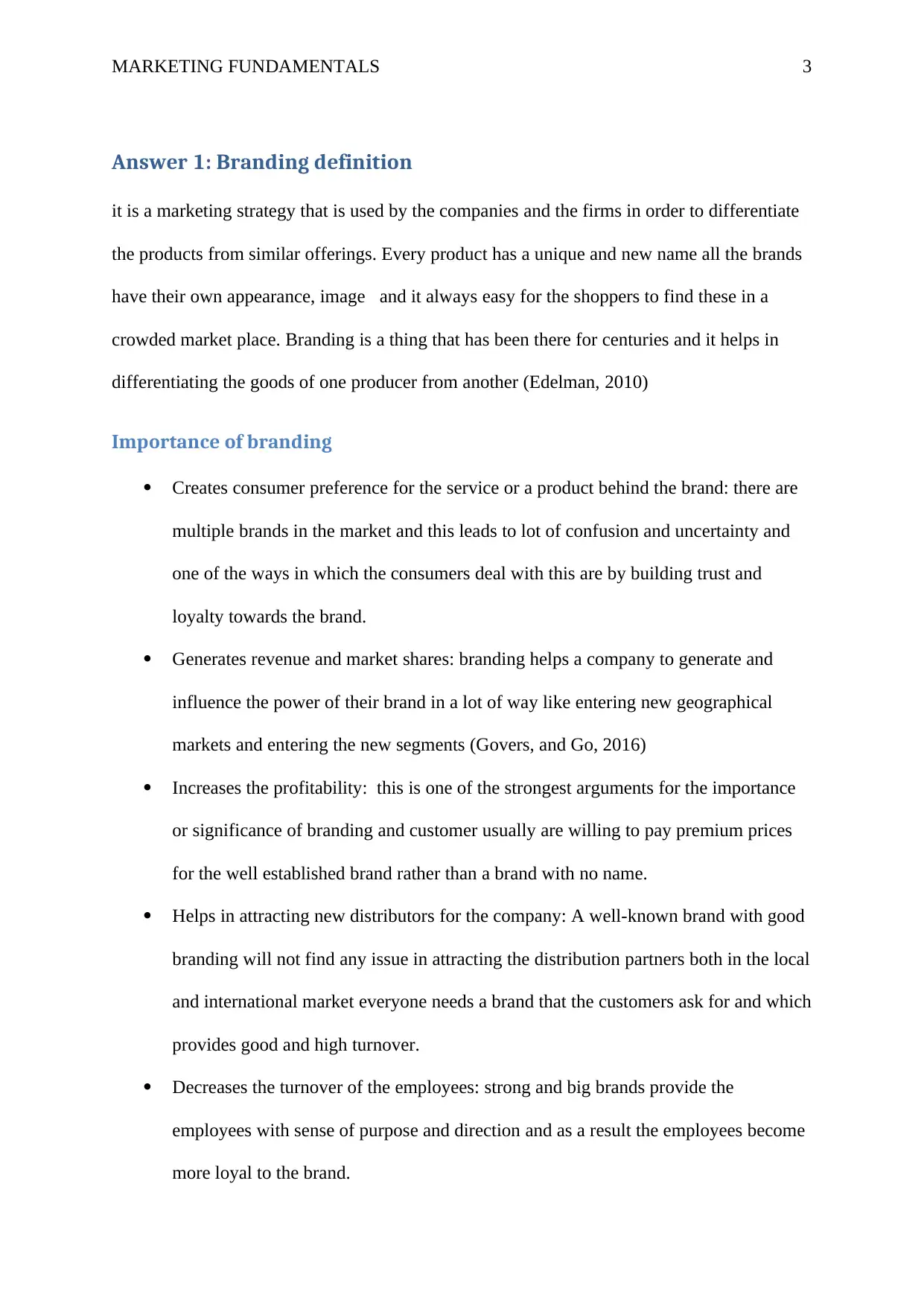
MARKETING FUNDAMENTALS 3
Answer 1: Branding definition
it is a marketing strategy that is used by the companies and the firms in order to differentiate
the products from similar offerings. Every product has a unique and new name all the brands
have their own appearance, image and it always easy for the shoppers to find these in a
crowded market place. Branding is a thing that has been there for centuries and it helps in
differentiating the goods of one producer from another (Edelman, 2010)
Importance of branding
Creates consumer preference for the service or a product behind the brand: there are
multiple brands in the market and this leads to lot of confusion and uncertainty and
one of the ways in which the consumers deal with this are by building trust and
loyalty towards the brand.
Generates revenue and market shares: branding helps a company to generate and
influence the power of their brand in a lot of way like entering new geographical
markets and entering the new segments (Govers, and Go, 2016)
Increases the profitability: this is one of the strongest arguments for the importance
or significance of branding and customer usually are willing to pay premium prices
for the well established brand rather than a brand with no name.
Helps in attracting new distributors for the company: A well-known brand with good
branding will not find any issue in attracting the distribution partners both in the local
and international market everyone needs a brand that the customers ask for and which
provides good and high turnover.
Decreases the turnover of the employees: strong and big brands provide the
employees with sense of purpose and direction and as a result the employees become
more loyal to the brand.
Answer 1: Branding definition
it is a marketing strategy that is used by the companies and the firms in order to differentiate
the products from similar offerings. Every product has a unique and new name all the brands
have their own appearance, image and it always easy for the shoppers to find these in a
crowded market place. Branding is a thing that has been there for centuries and it helps in
differentiating the goods of one producer from another (Edelman, 2010)
Importance of branding
Creates consumer preference for the service or a product behind the brand: there are
multiple brands in the market and this leads to lot of confusion and uncertainty and
one of the ways in which the consumers deal with this are by building trust and
loyalty towards the brand.
Generates revenue and market shares: branding helps a company to generate and
influence the power of their brand in a lot of way like entering new geographical
markets and entering the new segments (Govers, and Go, 2016)
Increases the profitability: this is one of the strongest arguments for the importance
or significance of branding and customer usually are willing to pay premium prices
for the well established brand rather than a brand with no name.
Helps in attracting new distributors for the company: A well-known brand with good
branding will not find any issue in attracting the distribution partners both in the local
and international market everyone needs a brand that the customers ask for and which
provides good and high turnover.
Decreases the turnover of the employees: strong and big brands provide the
employees with sense of purpose and direction and as a result the employees become
more loyal to the brand.
Secure Best Marks with AI Grader
Need help grading? Try our AI Grader for instant feedback on your assignments.
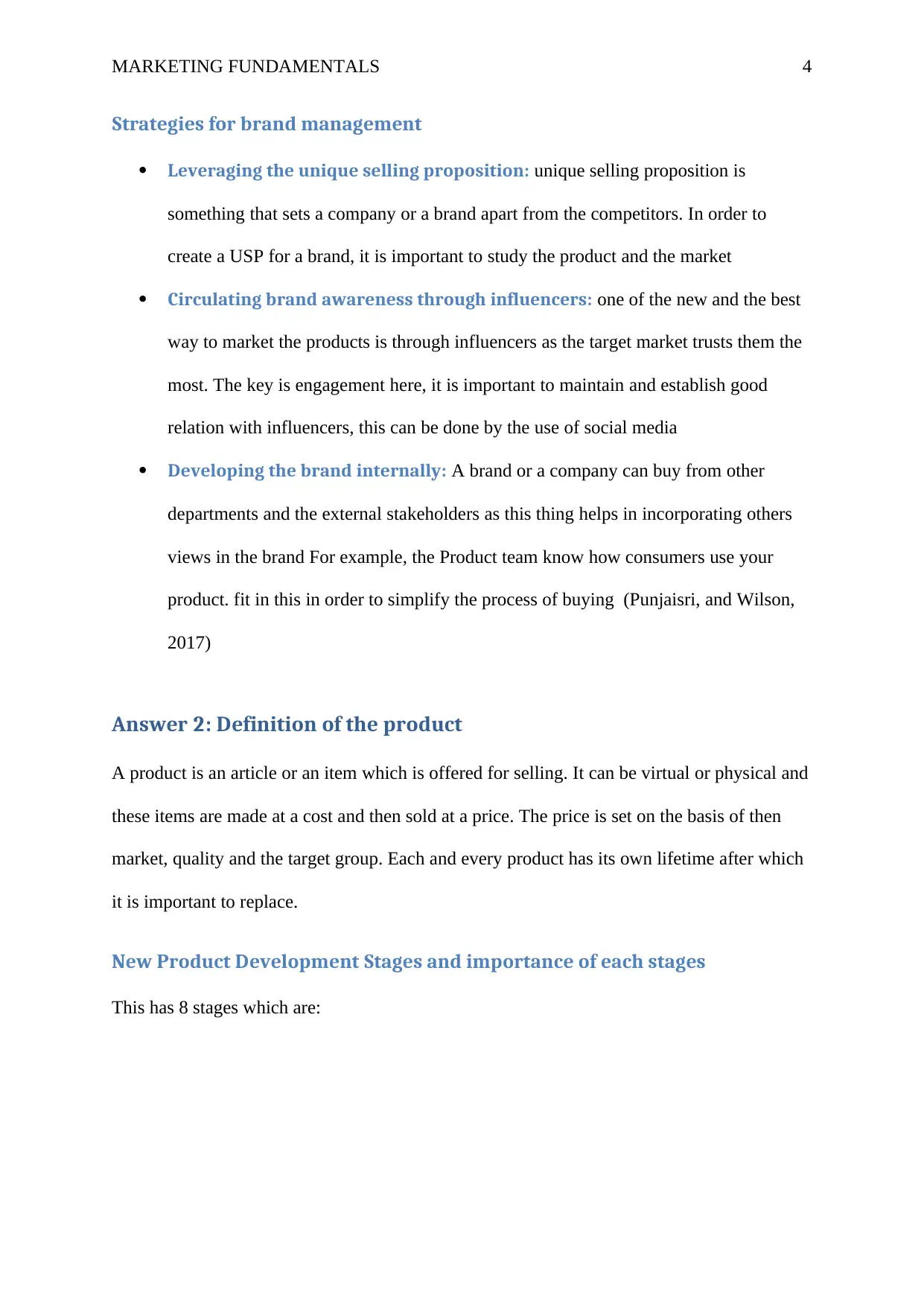
MARKETING FUNDAMENTALS 4
Strategies for brand management
Leveraging the unique selling proposition: unique selling proposition is
something that sets a company or a brand apart from the competitors. In order to
create a USP for a brand, it is important to study the product and the market
Circulating brand awareness through influencers: one of the new and the best
way to market the products is through influencers as the target market trusts them the
most. The key is engagement here, it is important to maintain and establish good
relation with influencers, this can be done by the use of social media
Developing the brand internally: A brand or a company can buy from other
departments and the external stakeholders as this thing helps in incorporating others
views in the brand For example, the Product team know how consumers use your
product. fit in this in order to simplify the process of buying (Punjaisri, and Wilson,
2017)
Answer 2: Definition of the product
A product is an article or an item which is offered for selling. It can be virtual or physical and
these items are made at a cost and then sold at a price. The price is set on the basis of then
market, quality and the target group. Each and every product has its own lifetime after which
it is important to replace.
New Product Development Stages and importance of each stages
This has 8 stages which are:
Strategies for brand management
Leveraging the unique selling proposition: unique selling proposition is
something that sets a company or a brand apart from the competitors. In order to
create a USP for a brand, it is important to study the product and the market
Circulating brand awareness through influencers: one of the new and the best
way to market the products is through influencers as the target market trusts them the
most. The key is engagement here, it is important to maintain and establish good
relation with influencers, this can be done by the use of social media
Developing the brand internally: A brand or a company can buy from other
departments and the external stakeholders as this thing helps in incorporating others
views in the brand For example, the Product team know how consumers use your
product. fit in this in order to simplify the process of buying (Punjaisri, and Wilson,
2017)
Answer 2: Definition of the product
A product is an article or an item which is offered for selling. It can be virtual or physical and
these items are made at a cost and then sold at a price. The price is set on the basis of then
market, quality and the target group. Each and every product has its own lifetime after which
it is important to replace.
New Product Development Stages and importance of each stages
This has 8 stages which are:
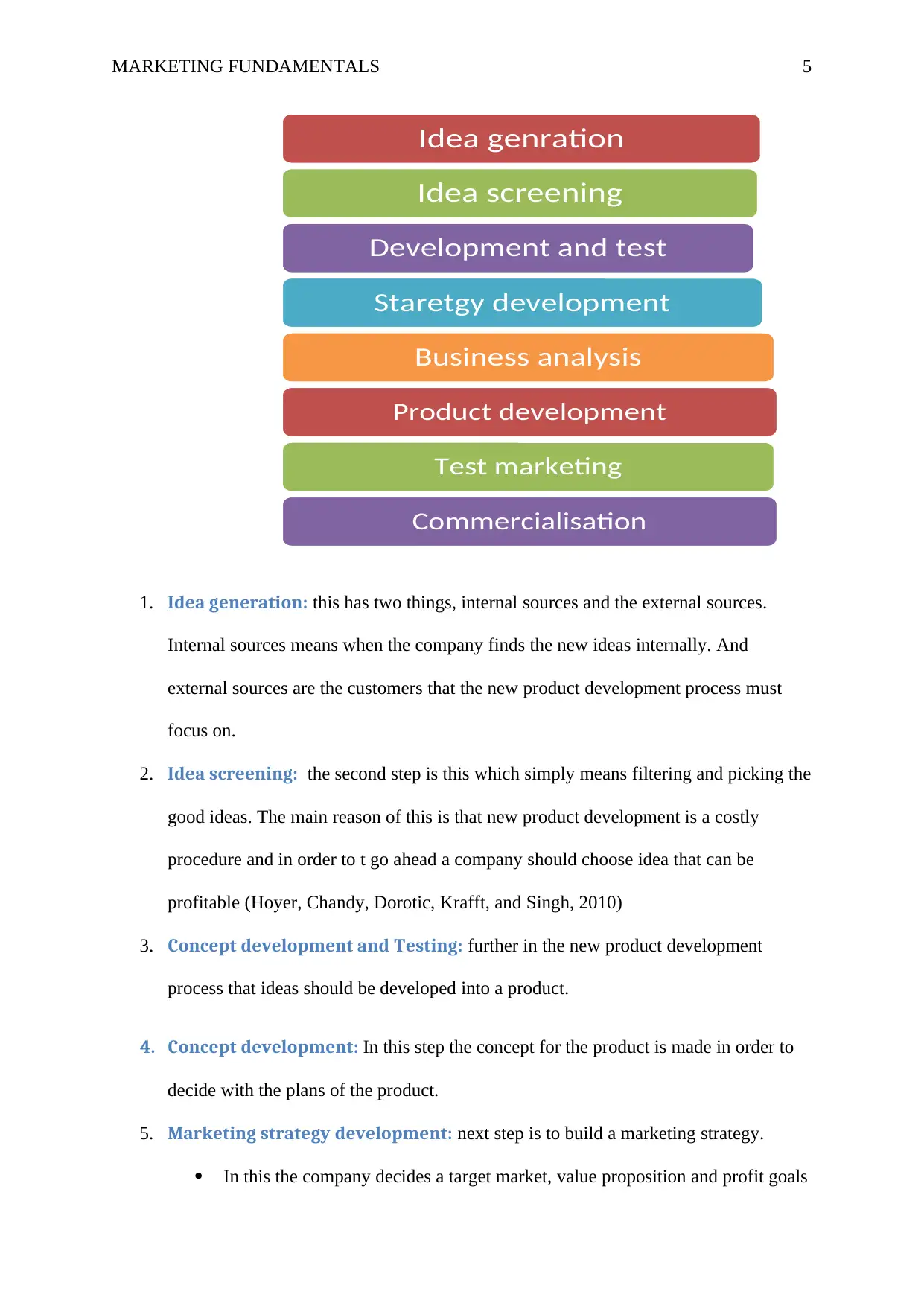
MARKETING FUNDAMENTALS 5
1. Idea generation: this has two things, internal sources and the external sources.
Internal sources means when the company finds the new ideas internally. And
external sources are the customers that the new product development process must
focus on.
2. Idea screening: the second step is this which simply means filtering and picking the
good ideas. The main reason of this is that new product development is a costly
procedure and in order to t go ahead a company should choose idea that can be
profitable (Hoyer, Chandy, Dorotic, Krafft, and Singh, 2010)
3. Concept development and Testing: further in the new product development
process that ideas should be developed into a product.
4. Concept development: In this step the concept for the product is made in order to
decide with the plans of the product.
5. Marketing strategy development: next step is to build a marketing strategy.
In this the company decides a target market, value proposition and profit goals
Idea genration
Idea screening
Development and test
Staretgy development
Business analysis
Product development
Test marketing
Commercialisation
1. Idea generation: this has two things, internal sources and the external sources.
Internal sources means when the company finds the new ideas internally. And
external sources are the customers that the new product development process must
focus on.
2. Idea screening: the second step is this which simply means filtering and picking the
good ideas. The main reason of this is that new product development is a costly
procedure and in order to t go ahead a company should choose idea that can be
profitable (Hoyer, Chandy, Dorotic, Krafft, and Singh, 2010)
3. Concept development and Testing: further in the new product development
process that ideas should be developed into a product.
4. Concept development: In this step the concept for the product is made in order to
decide with the plans of the product.
5. Marketing strategy development: next step is to build a marketing strategy.
In this the company decides a target market, value proposition and profit goals
Idea genration
Idea screening
Development and test
Staretgy development
Business analysis
Product development
Test marketing
Commercialisation
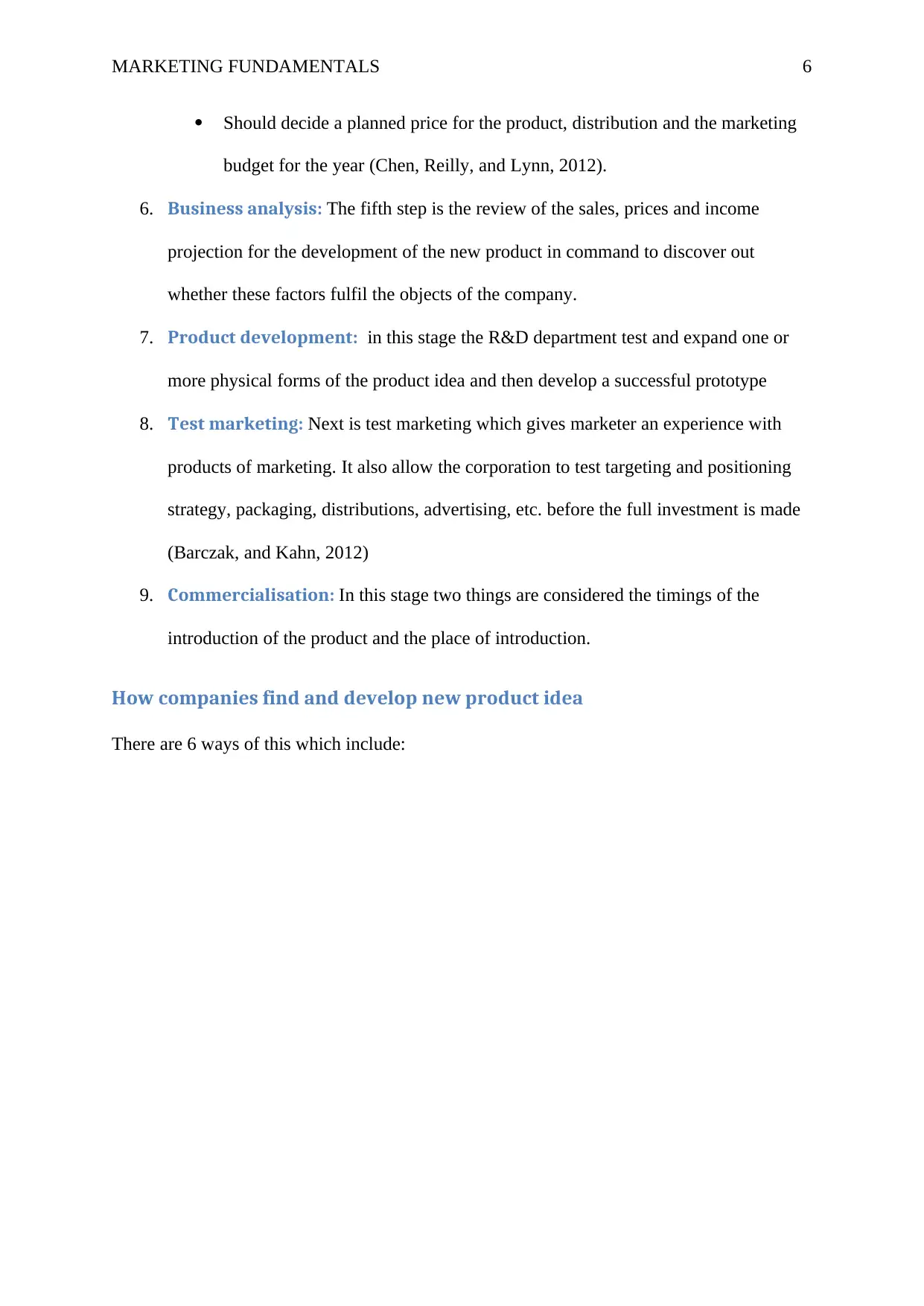
MARKETING FUNDAMENTALS 6
Should decide a planned price for the product, distribution and the marketing
budget for the year (Chen, Reilly, and Lynn, 2012).
6. Business analysis: The fifth step is the review of the sales, prices and income
projection for the development of the new product in command to discover out
whether these factors fulfil the objects of the company.
7. Product development: in this stage the R&D department test and expand one or
more physical forms of the product idea and then develop a successful prototype
8. Test marketing: Next is test marketing which gives marketer an experience with
products of marketing. It also allow the corporation to test targeting and positioning
strategy, packaging, distributions, advertising, etc. before the full investment is made
(Barczak, and Kahn, 2012)
9. Commercialisation: In this stage two things are considered the timings of the
introduction of the product and the place of introduction.
How companies find and develop new product idea
There are 6 ways of this which include:
Should decide a planned price for the product, distribution and the marketing
budget for the year (Chen, Reilly, and Lynn, 2012).
6. Business analysis: The fifth step is the review of the sales, prices and income
projection for the development of the new product in command to discover out
whether these factors fulfil the objects of the company.
7. Product development: in this stage the R&D department test and expand one or
more physical forms of the product idea and then develop a successful prototype
8. Test marketing: Next is test marketing which gives marketer an experience with
products of marketing. It also allow the corporation to test targeting and positioning
strategy, packaging, distributions, advertising, etc. before the full investment is made
(Barczak, and Kahn, 2012)
9. Commercialisation: In this stage two things are considered the timings of the
introduction of the product and the place of introduction.
How companies find and develop new product idea
There are 6 ways of this which include:
Paraphrase This Document
Need a fresh take? Get an instant paraphrase of this document with our AI Paraphraser
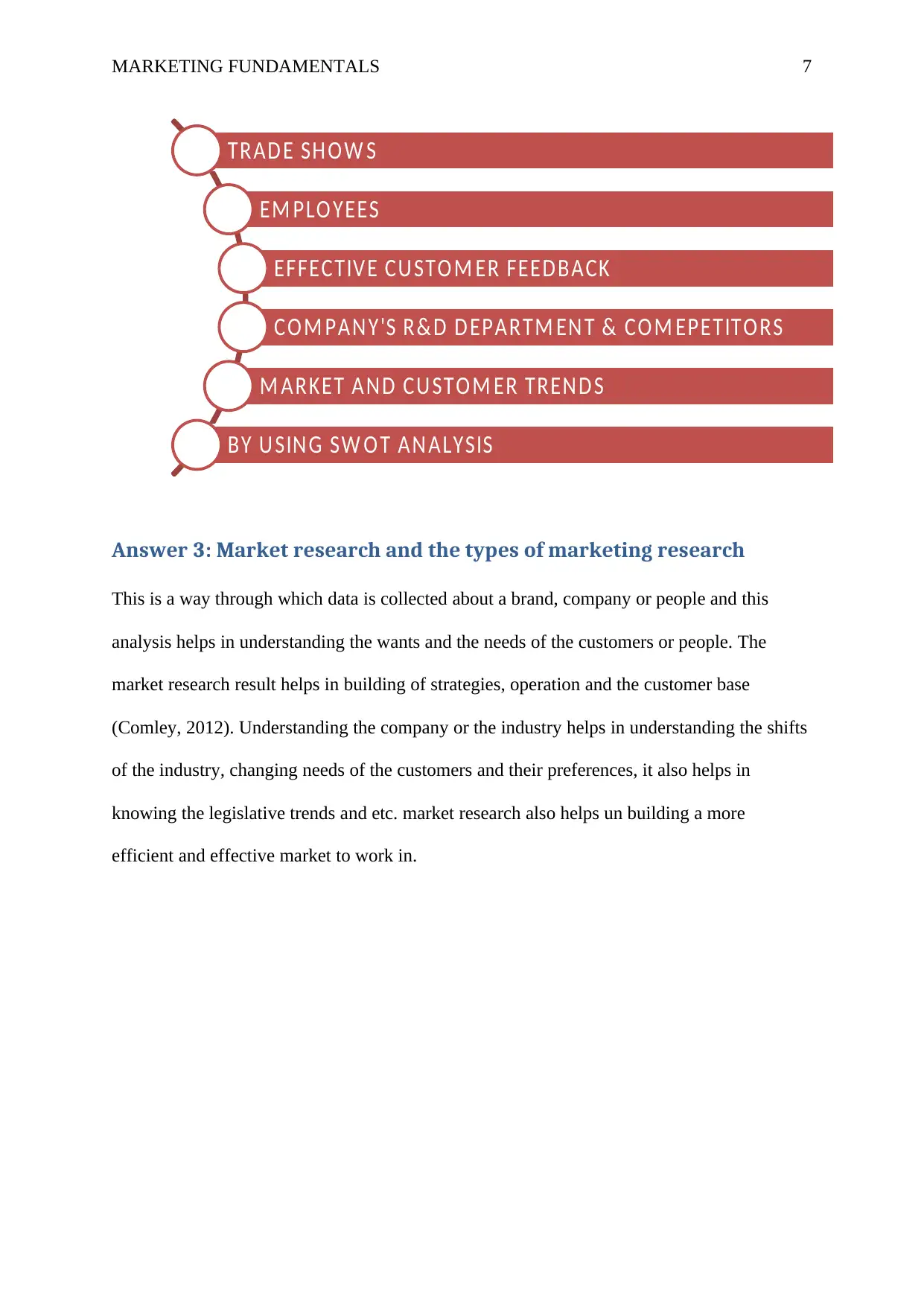
MARKETING FUNDAMENTALS 7
Answer 3: Market research and the types of marketing research
This is a way through which data is collected about a brand, company or people and this
analysis helps in understanding the wants and the needs of the customers or people. The
market research result helps in building of strategies, operation and the customer base
(Comley, 2012). Understanding the company or the industry helps in understanding the shifts
of the industry, changing needs of the customers and their preferences, it also helps in
knowing the legislative trends and etc. market research also helps un building a more
efficient and effective market to work in.
TRAD E SH O W S
EM PLO YEES
EFFECTIVE CU STO M ER FEED BACK
CO M PAN Y'S R& D D EPARTM EN T & CO M EPETITO RS
M ARKET AN D CU STO M ER TREN D S
BY U SIN G SW O T AN ALYSIS
Answer 3: Market research and the types of marketing research
This is a way through which data is collected about a brand, company or people and this
analysis helps in understanding the wants and the needs of the customers or people. The
market research result helps in building of strategies, operation and the customer base
(Comley, 2012). Understanding the company or the industry helps in understanding the shifts
of the industry, changing needs of the customers and their preferences, it also helps in
knowing the legislative trends and etc. market research also helps un building a more
efficient and effective market to work in.
TRAD E SH O W S
EM PLO YEES
EFFECTIVE CU STO M ER FEED BACK
CO M PAN Y'S R& D D EPARTM EN T & CO M EPETITO RS
M ARKET AN D CU STO M ER TREN D S
BY U SIN G SW O T AN ALYSIS
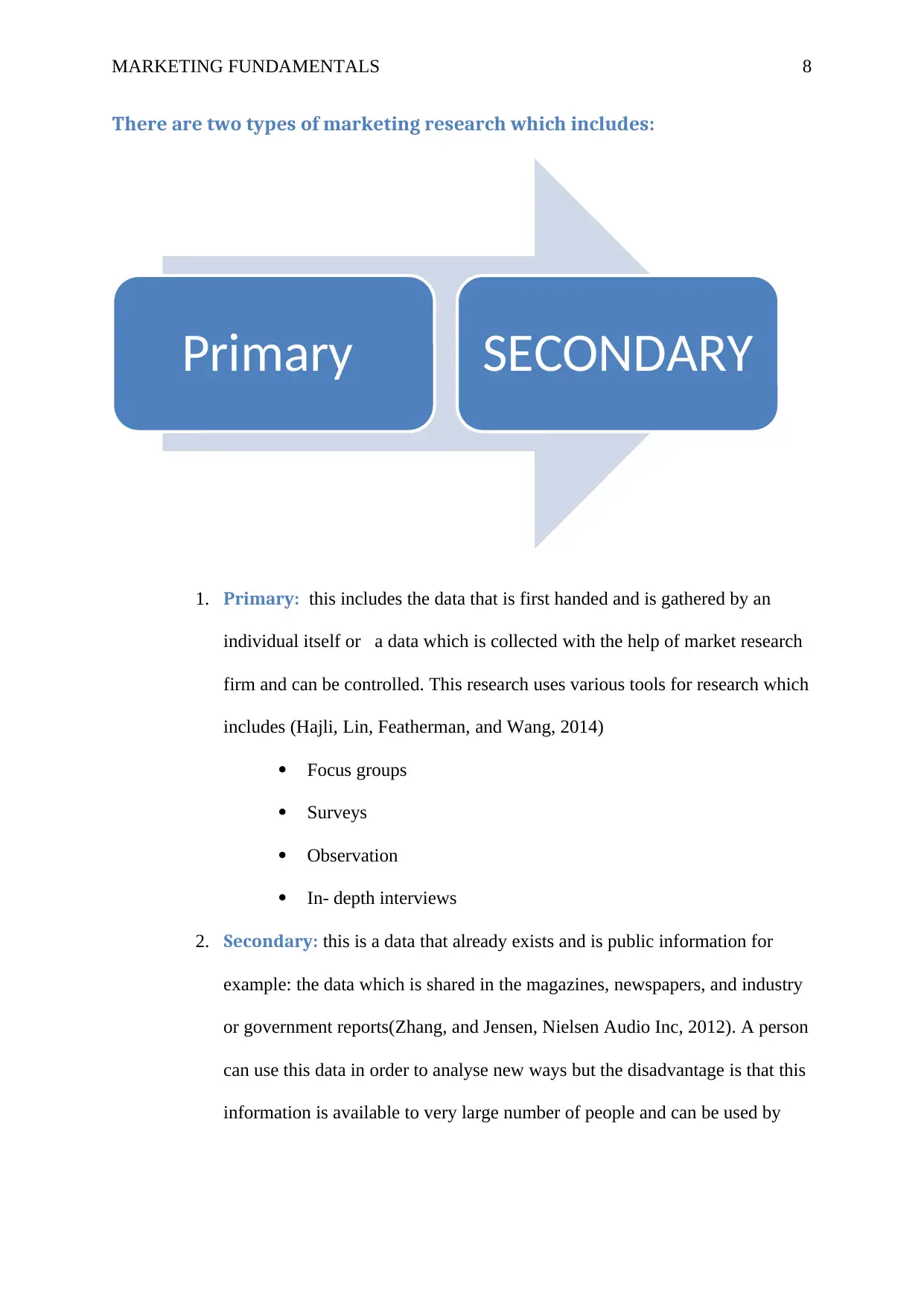
MARKETING FUNDAMENTALS 8
There are two types of marketing research which includes:
1. Primary: this includes the data that is first handed and is gathered by an
individual itself or a data which is collected with the help of market research
firm and can be controlled. This research uses various tools for research which
includes (Hajli, Lin, Featherman, and Wang, 2014)
Focus groups
Surveys
Observation
In- depth interviews
2. Secondary: this is a data that already exists and is public information for
example: the data which is shared in the magazines, newspapers, and industry
or government reports(Zhang, and Jensen, Nielsen Audio Inc, 2012). A person
can use this data in order to analyse new ways but the disadvantage is that this
information is available to very large number of people and can be used by
Primary SECONDARY
There are two types of marketing research which includes:
1. Primary: this includes the data that is first handed and is gathered by an
individual itself or a data which is collected with the help of market research
firm and can be controlled. This research uses various tools for research which
includes (Hajli, Lin, Featherman, and Wang, 2014)
Focus groups
Surveys
Observation
In- depth interviews
2. Secondary: this is a data that already exists and is public information for
example: the data which is shared in the magazines, newspapers, and industry
or government reports(Zhang, and Jensen, Nielsen Audio Inc, 2012). A person
can use this data in order to analyse new ways but the disadvantage is that this
information is available to very large number of people and can be used by
Primary SECONDARY
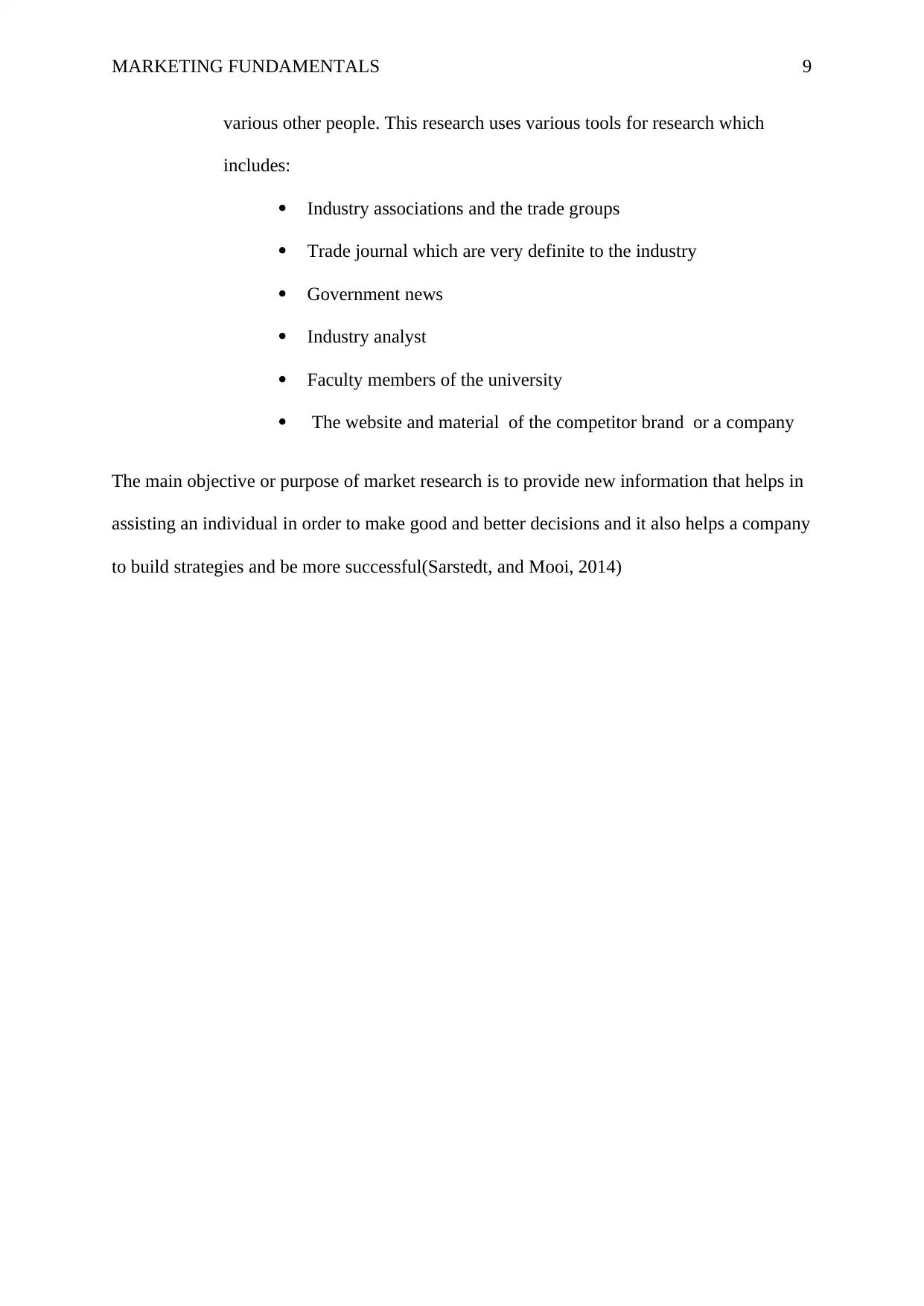
MARKETING FUNDAMENTALS 9
various other people. This research uses various tools for research which
includes:
Industry associations and the trade groups
Trade journal which are very definite to the industry
Government news
Industry analyst
Faculty members of the university
The website and material of the competitor brand or a company
The main objective or purpose of market research is to provide new information that helps in
assisting an individual in order to make good and better decisions and it also helps a company
to build strategies and be more successful(Sarstedt, and Mooi, 2014)
various other people. This research uses various tools for research which
includes:
Industry associations and the trade groups
Trade journal which are very definite to the industry
Government news
Industry analyst
Faculty members of the university
The website and material of the competitor brand or a company
The main objective or purpose of market research is to provide new information that helps in
assisting an individual in order to make good and better decisions and it also helps a company
to build strategies and be more successful(Sarstedt, and Mooi, 2014)
Secure Best Marks with AI Grader
Need help grading? Try our AI Grader for instant feedback on your assignments.
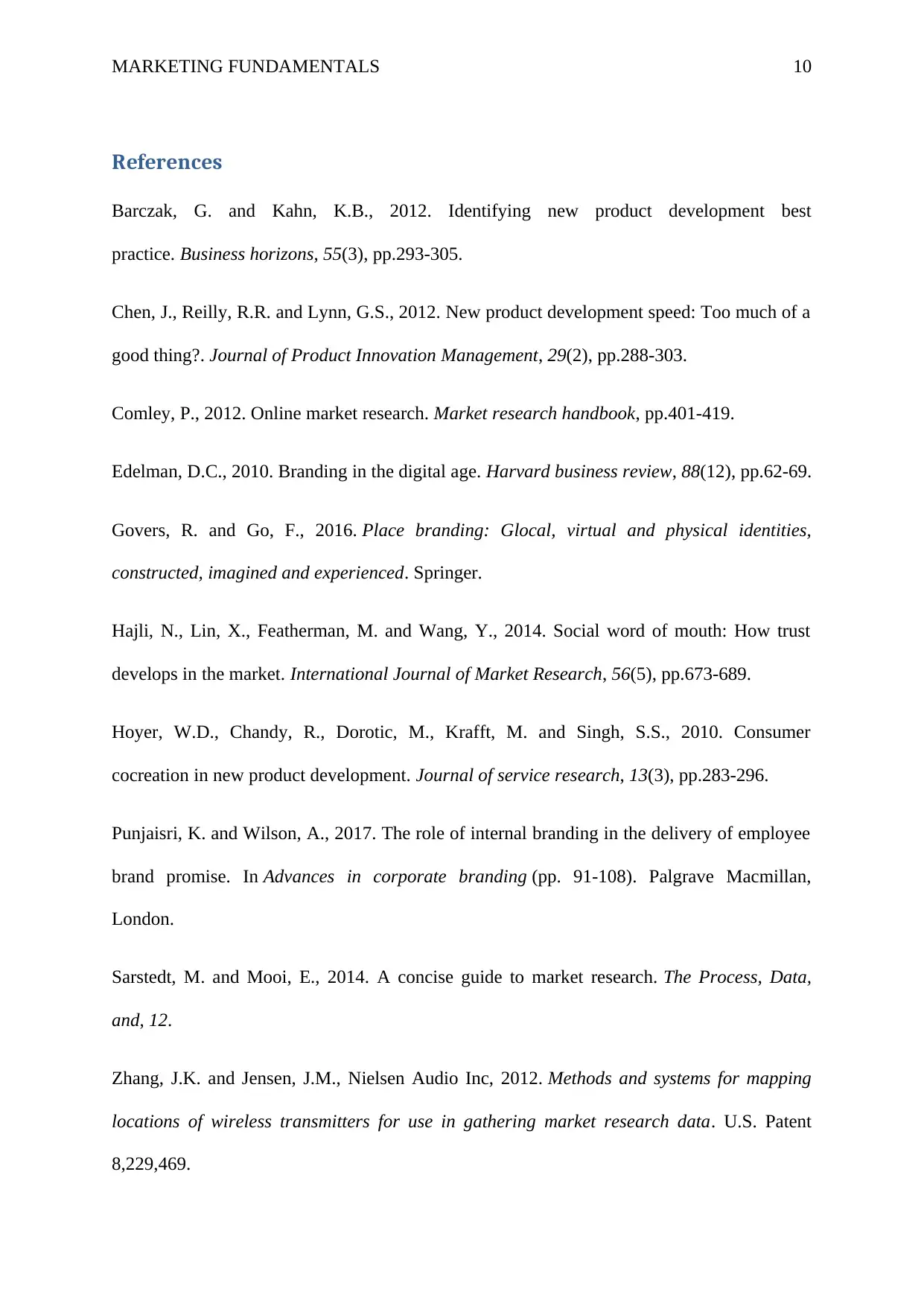
MARKETING FUNDAMENTALS 10
References
Barczak, G. and Kahn, K.B., 2012. Identifying new product development best
practice. Business horizons, 55(3), pp.293-305.
Chen, J., Reilly, R.R. and Lynn, G.S., 2012. New product development speed: Too much of a
good thing?. Journal of Product Innovation Management, 29(2), pp.288-303.
Comley, P., 2012. Online market research. Market research handbook, pp.401-419.
Edelman, D.C., 2010. Branding in the digital age. Harvard business review, 88(12), pp.62-69.
Govers, R. and Go, F., 2016. Place branding: Glocal, virtual and physical identities,
constructed, imagined and experienced. Springer.
Hajli, N., Lin, X., Featherman, M. and Wang, Y., 2014. Social word of mouth: How trust
develops in the market. International Journal of Market Research, 56(5), pp.673-689.
Hoyer, W.D., Chandy, R., Dorotic, M., Krafft, M. and Singh, S.S., 2010. Consumer
cocreation in new product development. Journal of service research, 13(3), pp.283-296.
Punjaisri, K. and Wilson, A., 2017. The role of internal branding in the delivery of employee
brand promise. In Advances in corporate branding (pp. 91-108). Palgrave Macmillan,
London.
Sarstedt, M. and Mooi, E., 2014. A concise guide to market research. The Process, Data,
and, 12.
Zhang, J.K. and Jensen, J.M., Nielsen Audio Inc, 2012. Methods and systems for mapping
locations of wireless transmitters for use in gathering market research data. U.S. Patent
8,229,469.
References
Barczak, G. and Kahn, K.B., 2012. Identifying new product development best
practice. Business horizons, 55(3), pp.293-305.
Chen, J., Reilly, R.R. and Lynn, G.S., 2012. New product development speed: Too much of a
good thing?. Journal of Product Innovation Management, 29(2), pp.288-303.
Comley, P., 2012. Online market research. Market research handbook, pp.401-419.
Edelman, D.C., 2010. Branding in the digital age. Harvard business review, 88(12), pp.62-69.
Govers, R. and Go, F., 2016. Place branding: Glocal, virtual and physical identities,
constructed, imagined and experienced. Springer.
Hajli, N., Lin, X., Featherman, M. and Wang, Y., 2014. Social word of mouth: How trust
develops in the market. International Journal of Market Research, 56(5), pp.673-689.
Hoyer, W.D., Chandy, R., Dorotic, M., Krafft, M. and Singh, S.S., 2010. Consumer
cocreation in new product development. Journal of service research, 13(3), pp.283-296.
Punjaisri, K. and Wilson, A., 2017. The role of internal branding in the delivery of employee
brand promise. In Advances in corporate branding (pp. 91-108). Palgrave Macmillan,
London.
Sarstedt, M. and Mooi, E., 2014. A concise guide to market research. The Process, Data,
and, 12.
Zhang, J.K. and Jensen, J.M., Nielsen Audio Inc, 2012. Methods and systems for mapping
locations of wireless transmitters for use in gathering market research data. U.S. Patent
8,229,469.
1 out of 11
Related Documents
Your All-in-One AI-Powered Toolkit for Academic Success.
+13062052269
info@desklib.com
Available 24*7 on WhatsApp / Email
![[object Object]](/_next/static/media/star-bottom.7253800d.svg)
Unlock your academic potential
© 2024 | Zucol Services PVT LTD | All rights reserved.




